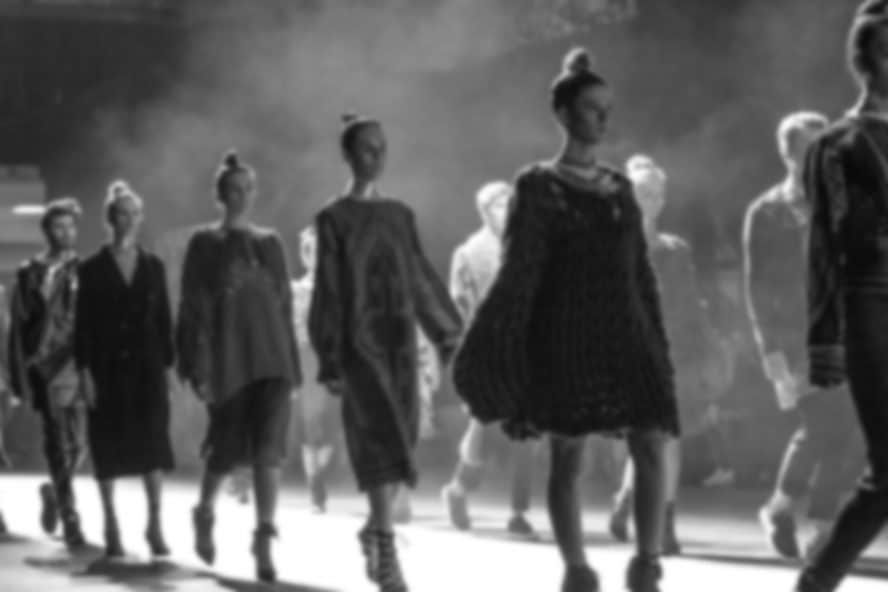After many months of a pandemic that is creating world-wide disruption of the fashion industry, we’re all grappling with the knowledge that the industry is going to change, and worrying about how our own business or career must pivot to adjust to our new reality.
For a decade, the fashion industry has strained under immense pressure from all directions, pressures which often push major brands to the brink of failure, prevent new brands from getting a foot-hold, and drives an endless cycle of waste that creates over 20% of the world’s water pollution. Now, the ultimate pressure has finally pushed the industry to the very edge as we come to grips with what we all must do to prevent spreading COVID-19.
The Council of Fashion Designers of American and the British Fashion Council has engaged in thoughtful discussions with their membership and published recommendations for how brands need to adjust in order to survive. Saint Laurent and GUCCI have announced that they will now only have two seasonless collections per year, leading the way for other major brands to follow.
As the cofounder of Fashion Mingle, a global platform for the independent fashion industry, and an 11-year veteran of New York Fashion Week, I enthusiastically embrace their recommendations and have some thoughts to add as well, that are specific to our membership, which is primarily comprised of entrepreneurs in the independent fashion industry that range from designers, production, beauty, media, and more.
CFDA and BFC Recommendations for the Fashion Industry
Slow Down. The CFDA and BFC are encouraging fashion brands and retailers to slow down. There are too many deliveries and too much merchandise generated. They are asking designers to be more strategic about how and when they intend to sell.
As a fashion designer, you’re intrinsically compelled to create. But let’s rethink how to channel that creativity to avoid waste of your financial resources. Are you creating a new collection just for the sake of creating? Do you have a realistic way of selling this collection and actually make money? This is the difference between having a hobby and having a business.
You must face reality, most independent designers will not sell their collection to a boutique or a department store, so focus on finding customers that want custom designs. As you build that clientele and perfect your unique aesthetic and fit, you will learn what is most popular with customers and start to sell it on your own e-commerce site. Over time, you can choose a marketplace for independent designers that will allow your business to grow at a pace that you can afford, and earn a reputation for delivering a high-quality product.
Shift Delivery. The CFDA and BFC is acknowledging the wide-spread complaint in the industry that there is a clear disconnect from when things arrive in-store to when the customer actually needs them. The retail industry needs to adjust inventory deliveries closer to the season for which it is intended.
Since the 2008 economic crisis, retail started training customers to think they were purchasing an item at a steep discount by artificially pricing an item really high, and then slapping a huge discount on it to manipulate us into purchasing a “good deal”. This created an endless cycle of the consumer refusing to purchase anything full price, forcing retailers to constantly markdown the next season’s collection from the moment it arrives in stores. This isn’t something a designer can control, but it is a conversation you should be having with the buyers you work with. This shift will take everyone working together at every level to achieve.
As an independent designer, you can take advantage of this disconnect in the retail industry by selling directly to consumers with the collection they need now. Even better, design collections that are multi-seasonal and can be layered so that your customers will be happy to pay a higher price for an investment piece of clothing that will deliver years of wear and endless styling options.
Reconnect to Creativity. The CFDA and BFC are asking designers to reduce the number of collections they create to no more than two main collections a year to reduce stress on designers and teams and have a positive effect on the wellbeing of the industry.
This endless drive by major brands to produce new collections at a breakneck pace has made working for a brand a nightmare experience. I cannot even count the number of fashion design graduates I know who have left the industry because of miserable working conditions. This drive to fill department stores and apparel marketplaces with a constant flow of something new is straining the industry at every level and creating over 90 million tons of waste each year.
If you have a buyer relationship that warrants creating 2 collections a year, go for it. If you don’t, then don’t keep creating collections. You’re wasting your financial resources and wasting the earth’s resources. Focus on defining and perfecting your unique aesthetic for your ideal customer. While you may get creative fulfillment from constantly designing something new, you’re not helping your business become profitable. Ask yourself, is this a hobby or a business? If you’re not making money, it’s a hobby. If you want to have a business, you have to run it like one. If you don’t know how to make your business profitable, then take fashion business courses online from someone like Boaz David of Human B or hire a fashion design consultant from our Fashion Mingle professional directory.
Reduce Fashion Shows. The CDFA and BFC are asking designers to focus on showing their most fashion forward designs only during the regular fashion calendar in the world’s fashion capitals to reduce the strain on traveling by buyers and journalists and also reducing each individual’s carbon footprint.
While this usually means New York, London, Paris and Milan, we’ve seen a massive increase in fashion shows in every corner of the world. Why is there such an increase? Because everyone wants to be a fashion show producer or fashion designer. The fashion show producer makes money, and while the designer gets some attention, they rarely see a return on their investment.
Really reflect on why you’re using financial resources to show your collection in a fashion show. Sure they are fun, and fulfill that creativity you desire, but what are you actually going to get out of the fashion show? Press mentions are rare and most often require payment now. You may get runway photos for your Instagram feed, but an editorial shoot would be cheaper. As a 20+ season veteran of New York Fashion Week, I can assure you that designers rarely get a buyer or a sale on their website from a fashion show audience. Getting a buyer is tedious, hard work. Getting a sale on your website requires digital advertising. Fashion shows rarely get you either.
While we’re all forced into this break in the industry, it’s critical to reflect. What do we want the world to be? This is our chance to make a major shift in the fashion industry and reduce the impact we are each having on global warming. Think critically about your business model. Where can you reduce waste? Where can you improve profitability? If you need guidance, please check out our Mingle Mastermind sessions we’re hosting every Friday on Zoom. We’re bringing you thought-provoking discussions and real-world solutions to help grow your fashion business.
- Good High School Letter Patches- 8 Key Characteristics - August 29, 2024
- Fashion Recruitment: Cultivating Talent in a Creative Industry - August 13, 2024
- Exploring the Intersection of Costume Design and Fashion at Parsons Q&A with Deborah Cantor - August 5, 2024
- 7 Steps To Creating Your Perfect Marketing Campaign - July 12, 2024
- What Are the Best Hair Vitamins for Women Over 50? - July 12, 2024


